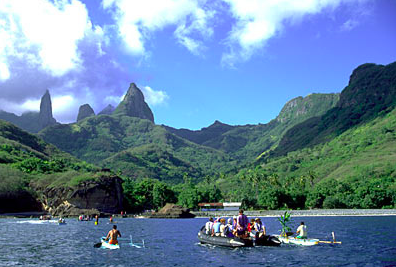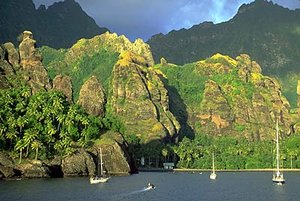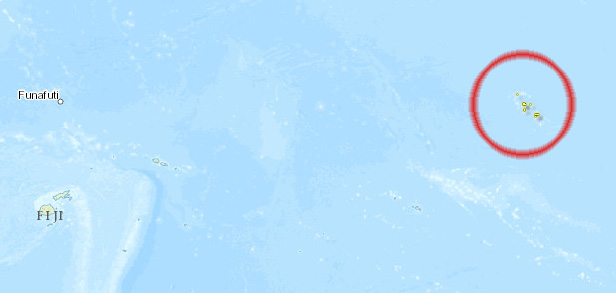Marquesas tropical moist forests

Ua Pou, Marquesas, French Polynesia. (Photograph by © Jack Stein Grove/Zegrahm Expeditions)
Introduction Like the Hawaiian Islands, the tropical Marquesas Islands are extremely isolated and all flora and fauna present are the result of long-distance colonization and in situ evolution for thousands to millions of years. Forty-two percent of the 320 native vascular plants are endemic. The terrestrial snail community is quite diverse, with at least 78 species represented. Ten endemic birds occur here. Unfortunately, this biodiversity (Marquesas tropical moist forests) has been exposed to almost two millennia of human disturbance. Several species have gone extinct in known history and much of the flora and fauna is critically endangered.
Location and General Description
The 12 Marquesas Islands are located approximately 5,500 kilometers (km) west of South America at 8º to 11ºS latitude and 139º to 141ºW longitude. All islands in the group are volcanic high islands with the northwest islands being approximately 6 million years old, and the southeast are the youngest at 1.3 million years old. The topography is very steep with knife-edged ridges, deeply dissected gorges and cliffs extending from mountaintops straight to sea level. Southeast trade winds are fairly constant year-round and moderate the rainfall and temperature, but long droughts can occur during El Niño cycles. Variation in topography and orientation produce variation in annual rainfall throughout the islands, ranging from 500 millimeters (mm) on lowland leeward coasts to more than 4,000 mm above 1,000 meters (m) on the five highest islands. Eastern upland areas tend to be wettest and coolest with mean temperatures from 15 to 25 °C while western lowlands are drier and hotter with temperatures averaging 25 to 29 °C.
Tropical moist forests are dominated by different species depending on elevation and rainfall. Lowland forest occurs up to about 300 m where annual precipitation is less than 2,000 mm. It is dominated by Pisonia grandis reaching 15 m, Thespesia populnea, Calophyllum inophyllum, and Terminalia glabrata. Tropical dry forest, with Hibiscus, Pandanus, Thespesia, and Cordia, once covered lower slopes on larger islands such as Eiao and Fau Huku. Mid-elevation forest with a canopy up to 20 m in height occurs between elevations of 300 to 800 m with annual rainfalls of 2,000 to 3,000 mm. Typical species include Hibiscus tiliaceus, Pandanus tectorius, Alphitonia marquesensis, Weinmannia parviflora, with an understory of Angiopteris evecta and Cyclophyllum barbatum. At slightly higher elevations, forests are dominated by Hernandia nukuhivensis, Cyathea affinis and C. feanii in wet areas, and Metrosideros collina and W. parviflora on drier slopes. Above 1,000 m, cool and misty conditions surround stunted cloud forest dominated by Cheirodendron bastardianum, Ilex anomala, and M. collina, and Freycinetia spp. climbers. Areas above 1,200 m are drier, and this windswept community supports a heathland less than 1 meter high dominated by M. collina, Vaccinium cereum, Styphelia tameiameiae, and Bidens spp. with grasses and ferns.
Biodiversity Features
 Fatu Hiva, French Polynesia. (Photograph by © Jack Stein Grove/Zegrahm Expeditions) The Marquesas are among the most isolated archipelagos in the world and thus have a highly endemic biota. The islands support 320 native vascular plant species with 42 percent endemism, including two endemic genera. There are approximately 200 introduced plant species. A number of genera including Asplenium, Psychotria, Bidens, Cyrtandra, Peperomia, Myrsine, Cyperus, and Melicope have numerous endemic species that evolved in the Marquesas from single ancestral species. The fern flora is particularly rich. Three plant species have become extinct and 16 species are endangered. The islands support a fairly rich invertebrate fauna with a notable diversity of at least 78 land and freshwater snail species and 16 fruit fly (Drosophila) species.
Fatu Hiva, French Polynesia. (Photograph by © Jack Stein Grove/Zegrahm Expeditions) The Marquesas are among the most isolated archipelagos in the world and thus have a highly endemic biota. The islands support 320 native vascular plant species with 42 percent endemism, including two endemic genera. There are approximately 200 introduced plant species. A number of genera including Asplenium, Psychotria, Bidens, Cyrtandra, Peperomia, Myrsine, Cyperus, and Melicope have numerous endemic species that evolved in the Marquesas from single ancestral species. The fern flora is particularly rich. Three plant species have become extinct and 16 species are endangered. The islands support a fairly rich invertebrate fauna with a notable diversity of at least 78 land and freshwater snail species and 16 fruit fly (Drosophila) species.
The Marquesas support 19 breeding seabird species and 11 resident land birds. The endangered ultramarine lory (Vini ultramarina) has declined from an archipelago-wide distribution prehistorically to only the island of Ua Huka recently. Today, a translocation program has reestablished a population on Fatu Hiva which is free of alien black rats (Rattus rattus) thought to be a major factor in its decline elsewhere. The red-mustached fruit-dove (Ptilinopus mercierii) has become extinct and the Nuku Hiva pigeon (Ducula galeata) has a population of fewer than a few hundred birds on Nuku Hiva Island. Other threatened or endangered endemic bird species include the Marquesas ground-dove (Gallicolumba rubescens), Marquesas kingfisher (Halcyon godeffroyi), Fatuhiva monarch (Pomarea whitneyi), Iphis monarch (P. iphis), and Marquesas monarch (P. mendozae).
Current Status
Human habitation has influenced Marquesan ecosystems for millennia. Polynesians colonized the islands between 1,000 to 2,000 years ago. They reached a population peak of about 80,000 inhabitants several hundred years ago which was accompanied by the destruction of most lowland vegetation and in the formation of grassland in drier, frequently burned areas. The archaeological work in the Marquesas has revealed an extensive history of extinction and extirpation of birds. Excavations on Ua Huka show that the island once supported 7 more seabird species than are present today and 13 land birds that are now gone, including 10 endemic rails, pigeons and parrots. Summary of all archaeological work indicates that 10 land birds became extinct and 7 bird species were extirpated from most of their range. All remaining endemic birds are considered threatened, some critically.
Designation of conservation areas in the Marquesas must be accompanied by major control efforts for alien species and fire, and habitat restoration efforts. Two reserves, Eiao Island and the dry forest reserve on Mohotani, have been so totally denuded by feral sheep and other animals that rainfall washes away so much soil that plants cannot regenerate. Introduced great horned owl and common myna are thought to greatly impact native bird species on Hiva Oa. In addition to mammals, birds, and rats, the introduced plant Miconia magnifica is established and spreading. It has the potential to completely replace all native forest as its congener has done in parts of Tahiti. Hunting is a major factor in the endangerment of the Nuku Hiva or Marquesan imperial-pigeon, a species with less than 300 individuals left.
The protection and management of upper-elevation forests on Ua Pou, Nuku Hiva, Fatu Hika, Ua Huku, and Fatu Hiva Islands would serve to protect large numbers of endemic plant species and the unique communities they form.
Types and Severity of Threats
Lowland forests were completely replaced with introduced species. Following European contact, introduced diseases wiped out all but approximately 3,800 Polynesian inhabitants. The subsequent introduction of herbivorous and predatory mammals has had an even more catastrophic effect on upland flora and fauna. Frequent fires have also transformed many natural habitats and works to maintain introduced communities. Uninhabited islands, such as Hatutaa, that are protected from human habitation and mammals still support large numbers of seabirds and land birds, but few areas of natural forest are currently included in the reserve system.
Justification of Ecoregion Delineation
This ecoregion consists of the relatively discrete Marquesas Islands group. Allison treats the Cooks, Societies, Tuamotus, and Marquesas as a unit herpetologically as they share a similar reptile assemblage. Van Balgooy similarly lumps the Cooks, Niue, Societies, Tuamotus, Tubaui, and Marquesas based on floristic affinities. However, Birdlife International separates the Marquesas from surrounding island groups due to the presence of 10 endemic bird species, and based on this consideration we have delineated the Marquesas as a separate ecoregion.
Additional information on this ecoregion
- For a shorter summary of this entry, see the WWF WildWorld profile of this ecoregion.
- To see the species that live in this ecoregion, including images and threat levels, see the WWF Wildfinder description of this ecoregion.
- World Wildlife Fund Homepage
Further Reading
- Adamson, A.M. 1935. Affinities and origins of the fauna of the Marquesas Islands. PhD dissertation University of California, Berkeley. 205 pp.
- Adamson, A.M. 1936. Marquesan insects: environment. Bernice P. Bishop Museum Bulletin 139:1-73.
- Brown, F.B.H. 1931. Flora of southeastern Polynesia. I. Monocotyledons. Bernice P. Bishop Museum Bulletin 84:1-194.
- Brown, F.B.H. 1935. Flora of southeastern Polynesia. III. Dicotyledons. Bernice P. Bishop Museum Bulletin 130:1-386.
- Dahl, A.L. 1980. Regional ecosystems survey of the South Pacific area. South Pacific Commission, Noumea, New Caledonia.
- Dekker, B.G. 1992. Secondary plant cover on upland slopes: Marquesas Islands, French Polynesia. Atoll Research Bulletin 363:1-36.
- Florence, J. and D.H. Lorence. 1997 Introduction to the flora and vegetation of the Marquesas Islands. Allertonia 7:226-237.
- Kuehler, C., A. Lieberman, A. Varney, P. Unitt, R.M. Sulpice, J. Azua, and B. Tehevini. 1997. Translocation of Ultramarine Lories, Vini ultramarina, in the Marquesas Islands: Ua Huka to Fatu Hiva. Bird Conservation International 7:69-79.
- Montgomery, S.L., W.C. Gagne, and B.H. Gagne. 1980. Notes on birdlife and nature conservation in the Marquesas and Society Islands. ‘Elepaio 40:152-156.
- Mueller-Dombois, D. and F.R. Fosberg. 1998. Vegetation of the Tropical Pacific Islands. Springer Press, New York. ISBN: 038798285X
- Rolett, B.V. 1993. Marquesan prehistory and the origins of East Polynesian culture. Jounral de la Societe des Oceanisttes 96:29-47.
- Seitre, R. and J. Seitre. 1992. Causes of land-bird extinctions in French Polynesia. Oryx 26:215-222.
- Stattersfield, A.J., M.J. Crosby, A.J. Long, and D.C. Wege. 1998. Endemic Bird Areas of the World: Priorities for biodiversity conservation. BirdLife Conservation Series no. 7, BirdLife International, Cambridge, UK. 846 pp. ISBN: 0946888337
- Steadman, D.W. 1995. Prehistoric extinctions of Pacific island birds: biodiversity meets zooarchaeology. Science 267:1123-1130.
- Steadman, D.W. and B. Rolett. 1996. A chronostratigraphic analysis of landbird extinction on Tahuata, Marquesas Islands. Journal of Archaeological Science 23:81-94.
- Thibualt, J.-C. 1988. Menacés et conservation des oiseaux de Polynésie Française. Pages 87-124 in J.-C. Thibualt and I. Guyot, eds. Livre rouge des oiseaux menacés des régions françaises d’outre-mer. Conseil Internatioal pur la Protection des Oiseaux (Monograph 5), Saint-Cloud.
- Van Balgooy, P.H. Hovenkamp, and P.C. Van Welzen. 1996. Phytogeography of the Pacific – floristic and historical distribution patterns in plants. Pages 191-213 in Keast, A. and S.E. Miller, editors. The origin and evolution of Pacific island biotas, New Guinea to Eastern Polynesia: Patterns and processes. SPB Academic Publishing, Amsterdam. ISBN: 905103136X
- Wagner, W.L. 1991. Evolution of waif floras: a comparison of the Hawaiian and Marquesan archipelagos. Pages 267-284 in E. Dudley, editor. The Unity of evolutionary biology. The proceedings of the 4th International Congress of Systematics and Evolutionary Biology. Dioscorides Press, Portland, Oregon. ISBN: 0931146194
- WWF and IUCN. 1995. Centres of plant diversity. A guide and strategy for their conservation. Vol. 2. Asia, Australasia and the Pacific. IUCN Publication Unit, Cambridge, UK. ISBN: 2831701988
| Disclaimer: This article is taken wholly from, or contains information that was originally published by, the World Wildlife Fund. Topic editors and authors for the Encyclopedia of Earth may have edited its content or added new information. The use of information from the World Wildlife Fund should not be construed as support for or endorsement by that organization for any new information added by EoE personnel, or for any editing of the original content. |

1 Comment
alisha lopej wrote: 11-17-2010 15:26:30
Marquesas Islands are an archipelago in the South Pacific, located in French Polynesia. Canopies are believed to have been settled by Polynesians more than two thousand years, probably from the islands of Tonga and Samoa. It is a truly unique place to be in this place has served as an outlet for artists, writers, adventurers and musicians too. http://www.travelaustralia360.com/marquesas-island.html